
Author: JacobZhao Source: mirror Translation: Shan Oppa, Bitchain Vision
In several segments of the current crypto industry,Stablecoin paymentandDeFi applicationsAs two have been verifiedReal-world demand and long-term valueThe track continues to show strong development potential.at the same time,The thriving AI AgentIt is becoming the actual interface for users in the AI industry, and gradually assumes the core interaction role between AI and users.
existCrypto and AI are in the trend of integration, especially in the exploration of how AI feeds back encryption applications, it currently focuses on three typical application scenarios:
1. Dialogue-type intelligent body
Including chatbots, virtual partners, AI assistants, etc.Although many are still “wrappers” of universal mockups,Low development threshold and natural interaction, coupled with the token incentive mechanism, it has become the first type of product to reach users and get the most attention.
2. Information integration intelligent body
This type of agent mainly deals with the integration and interpretation of on-chain and off-chain data.Projects such asKaito,AIXBTHave achieved initial success in information aggregation at the web layer.
However, on-chain data integration is still in the exploration stage, and no clear market leader has appeared.
3. Strategy execution type intelligent body
Such agentsStablecoin paymentandDeFi policy automationAs the core, two main directions are derived:
-
Agent Payment
-
DeFAI (AI Agent in Decentralized Finance)
They are deeply embedded in on-chain transactions and asset management logic, and have the ability to move from “hype” toSustainable, efficiency-driven financial automation infrastructurepotential.
This article focuses onThe evolution path of the integration of DeFi and AI, sort out the stage transition from automation to intelligent agents, and deeply analyze the infrastructure, application space and core challenges behind policy execution agents.
Three stages of DeFi intelligence: From automation to Copilot to AgentFi
The evolution of DeFi intelligence can be divided into three gradual stages:
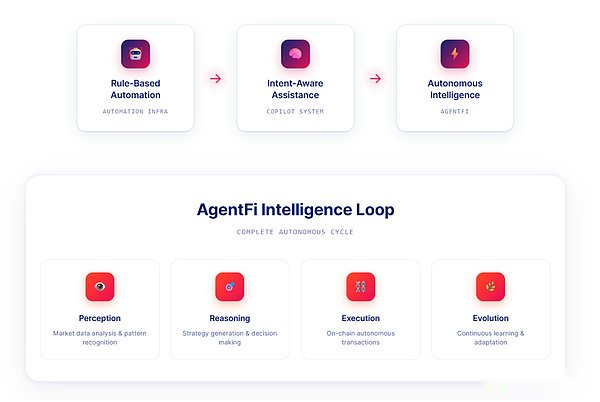
1. Automation infrastructure
This stage is triggered based on rules and performs preset operations, such as arbitrage, asset rebalancing, stop loss, etc.The system cannot generate strategies on its own and is not autonomous, essentially “mechanical” execution logic.
2. Intent-driven Copilot
Introduce intent recognition and semantic analytic capabilities.Users can enter instructions through natural language, and the system is responsible for understanding and decomposing operational intentions.Give suggestions for executable paths.But at this stageStill relying on user confirmation, unable to complete the closed loop of decision-making and execution independently.
3. AgentFi (Smart Agent Finance)
Implement a complete intelligent closed loop:Perception → Inference/Strategy Generation → On-chain execution → Continuous evolution.AgentFi represents true possessionAutonomous execution and adaptive learning abilityThe on-chain agent can continuously optimize decision logic based on experience and achieve self-evolution.
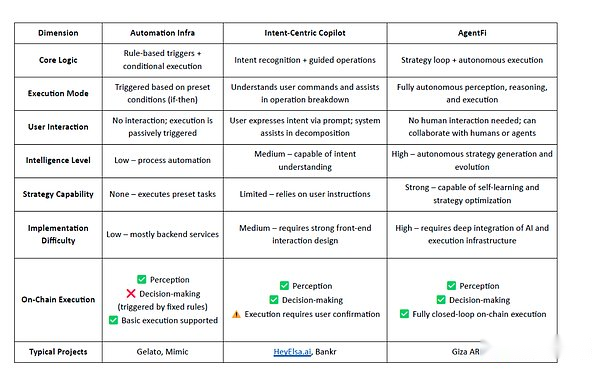
To determine whether a project is truly eligible to be AgentFi, it must meet at least three of the following five core criteria:
-
Autonomous perception of on-chain status/market signals (not static input, but real-time monitoring)
-
Strategy generation and formulation capabilities (not only preset strategies, but also the ability to create situational action plans independently)
-
Execute on the independent chain (can perform complex operations such as exchange/loan/pled without manual intervention)
-
Persistent state and evolutionary capabilities (agents have life cycles that can run continuously and adjust behavior based on feedback)
-
Agent native architecture (dedicated proxy SDK, dedicated execution environment, and intent routing or execution middleware designed to support autonomous proxy)
In other words: Automatic trading ≠Copilot, of course ≠AgentFi.
-
Automatic trading is just oneRules-based trigger system;
-
The co-pilot can interpret user intentions and provide actionable suggestions, but still rely on human input;
True AgentFi refers to agents with perceptual, reasoning, and execution capabilities on autonomous chains that are able to close policy loops and evolve over time without human intervention.
Analysis of the applicability of DeFi use cases:
In decentralized finance (DeFi), core applications are usually divided into two categories:
-
Token Capital Market: Asset Circulation and Exchange
-
Fixed Income: Financial Strategy for Generating Income
We believe that there are significant differences in compatibility with intelligent execution:
1. Token Capital Market: Asset Circulation and Trading Scenarios
These involve atomic interactions, such as Swap transactions, cross-chain bridges, fiat currency up and downhills, and their core features are “intention-driven + single-step atomic execution” and do not involve profit strategies, state persistence or evolutionary logic.Therefore, they are more suitable for intention-centric Copilot and do not constitute AgentFi.
Due to the low technical threshold and simple interaction, most DeFAI projects currently belong to this category and have not formed a closed-loop AgentFi system.
However, more advanced swap strategies—such as cross-asset arbitrage, permanent hedging LP, leverage rebalancing may require the capability of AI agents, although such implementations are still in the early stages of exploration.
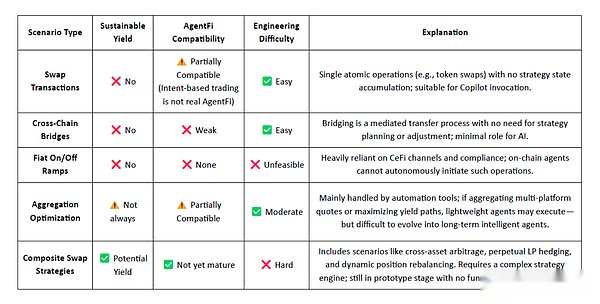
2.Income-based financial scenariosThe income-based financial scenario is naturally in line with AgentFi’s “strategy closed loop + autonomous execution” model, and has the characteristics of clear income goals, complex strategy combinations and dynamic state management.Its key features include:
-
Quantitative return goals (APR/APY) enable agents to build optimization capabilities;
-
A broad strategic design space involving multi-asset, multi-term, multi-platform, and multi-step interactions;
Frequent management and real-time adjustments make it ideal for on-chain proxy execution and maintenance.
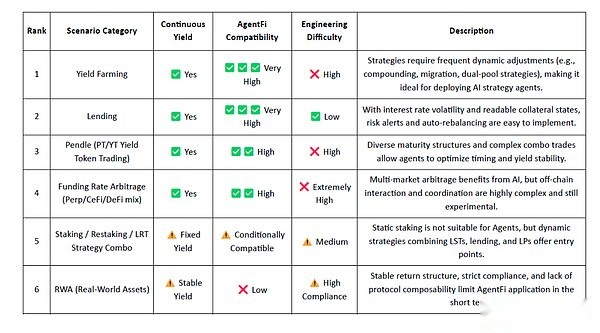
Due to many factors such as income duration, fluctuation frequency, on-chain data complexity, cross-protocol integration difficulty, compliance restrictions, and other factors, there are large differences in AgentFi compatibility and engineering feasibility in different income scenarios.It is recommended to give priority to the following scenarios:
High priority implementation scenarios:
-
Lending: Interest rate fluctuations are easy to track, and perform logic is standardized – ideal for lightweight agents.
-
Income mining: The liquidity pool is highly dynamic, the strategy combination is diverse, and the return fluctuates greatly.AgentFi can significantly improve annualized rate of return (APY) and interaction efficiency, but the project implementation is difficult.
Medium- and long-term exploration directions:
-
Pendle Earnings Trading: The time dimension and return curve are clear, suitable for agents to manage rollouts and interpool arbitrage.
-
Fund rate arbitrage: Theoretical returns are attractive, but need to be solved by cross-market execution and off-chain interaction challenges – high engineering complexity.
-
LRT (Liquid Restaking Token) Dynamic Portfolio Management: Static staking is not suitable; the potential lies in combining LRT with LP, lending and automatic rebalancing strategies.
-
RWA multi-asset portfolio management: difficult to implement in the short term.Agents can assist with portfolio optimization and maturity planning.
Intelligent DeFi scenarios:
1. Automation tools: rule triggers and conditional execution
Gelato is one of the earliest DeFi automation infrastructures that supported conditional task execution for protocols such as Aave and Reflexer.Later, it transformed into a Rollup as a service provider.Currently, the main battlefield of on-chain automation has moved to DeFi asset management platforms such as DeFi Saver and Instadapp, which provide standardized automation modules such as limit orders, forced leveling protection, automatic rebalancing, DCA and grid strategies.
Some of the more advanced DeFi automation platforms include:
Mimic.fi– https://www.mimic.fi/
An on-chain automation platform for DeFi developers and projects that support programmable automation across chains such as Arbitrum, Base, and Optimism.Its architecture includes: planning (task and trigger definition), execution (intention broadcast and competition execution), security (triple-fold verification and risk control).Currently developed based on SDK and is in the early stage of deployment.
AFI protocol– https://www.afiprotocol.ai/
An algorithm-driven proxy execution network that supports 24/7 unmanaged automation.It targets the problems of decentralized execution, high policy thresholds and poor risk response in DeFi.It provides programmable policies, permission controls, SDK tools, and a native income stablecoin afiUSD.Currently in-house testing is being conducted at Sonic Labs and is not open to the public or retail investors.
2. Intent-centered Copilot: Intent Expression and Implementation of Recommendations
The DeFAI narratives that emerged at the end of 2024 (excluding speculative meme-token projects) are mostly intention-centric Copilots—users express their intentions in natural language, and the system recommends actions or performs basic on-chain operations.
The core capabilities are still at the stage of “intention identification + co-pilot assistance execution”, and lack strategic closed loop and continuous optimization.Due to the limitations in semantic understanding, cross-protocol interaction, response feedback, etc., most users have poor experience and limited functions.
Notable items include:
HeyElsa– https://app.heyelsa.ai/
HeyElsa is the AI co-pilot of Web3, which allows users to perform operations such as transactions, bridges, NFT purchases, stop loss settings, and even create Zora tokens in natural language.As a powerful conversational cryptocurrency assistant, it is for beginners, super-advanced users, and veteran traders, and is fully online and run on more than 10 blockchains.With 1 million daily transaction volume, 3,000 to 5,000 daily active users, HeyElsa integrates revenue optimization strategies and automated intent execution, laying a solid foundation for AgentFi.
Bankr– https://bankr.bot/
Bankr is an intention-based transaction assistant that integrates artificial intelligence, DeFi and social interaction capabilities.Users can issue natural language commands through X or their dedicated terminals to perform redemption, limit orders, bridging, token issuance, NFT minting and other operations on Base, Solana, Polygon and Ethereum main networks.Bankr builds a complete “Intent → Compile → Execution” process, focusing on minimalist user interface and seamless integration with social platforms.It uses token incentives and earnings sharing to drive growth.
Griffain– https://griffain.com/
A multi-functional AI proxy platform built on Solana.Users can interact with Griffain Copilot through natural language to query assets, trade NFTs, manage LPs, etc.The platform supports multiple proxy modules and encourages the community to build proxy.It is built on the Anchor Framework and integrates with Jupiter, Tensor, etc., emphasizing mobile compatibility and composability.Currently supports more than 10 core proxy modules and has strong execution capabilities.
Symphony– https://www.symphony.io/
The execution infrastructure built for AI agents builds a full-stack system that includes intent modeling, intelligent routing discovery, RFQ execution and account abstraction.Their conversation assistant, Sympson, provides real-time market data and strategy advice, but has not yet provided full on-chain execution.Symphony provides the basic components for AgentFi and is committed to supporting collaborative agent execution and cross-chain operations in the future.
HeyAnon– https://heyanon.ai/
A DeFAI platform integrating intent interaction, on-chain execution and intelligent analysis.Supports multi-chain deployment (Ethereum, Base, Solana, etc.) and cross-chain bridges (LayerZero, deBridge).Users can use natural language to exchange, borrow, pledge, and analyze market sentiment and on-chain dynamics.Despite the attention of founder Sesta, DeFAI is still in the Copilot stage, and the strategy and execution intelligence are not yet perfect.Its long-term feasibility is still under test.
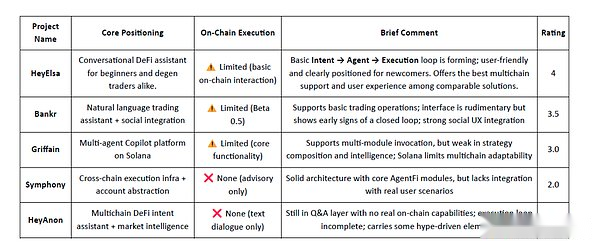
The above scoring system is mainly based on the usability of the product, user experience and the feasibility of the public roadmap during the author’s evaluation.It reflects a high degree of subjectivity.Please note that this assessment does not contain any code security audits and should not be considered investment advice.
3. AgentFi agent: closed-loop policy and autonomous execution
We believe that compared with intention-centric Copilot, AgentFi represents a more advanced paradigm in the evolution of DeFi’s intelligent evolution.These agents have independent revenue strategies and on-chain independent execution capabilities, which can significantly improve users’ execution efficiency and capital utilization.
In 2025, we are delighted to see that more and more AgentFi projects have been launched or are under development, focusing mainly on lending and liquidity mining.Among them, the projects worth paying attention to include Giza ARMA, Theoriq AlphaSwarm, Almanak, Brahma, Olas agent series, etc.
ARMA– https://arma.xyz/
ARMA is a smart proxy product launched by Giza, aiming to optimize the yield of cross-protocol stablecoins.ARMA is deployed on Base and supports mainstream lending protocols such as Aave, Morpho, Compound and Moonwell, and has key functions such as cross-protocol rebalancing, automatic compounding and smart asset switching.The ARMA strategy system monitors the annual interest rate (APR), transaction costs and rate of return spreads in real time, and adjusts the configuration independently to achieve a yield that is far higher than the static position.
Its modular architecture includes: smart accounts, session keys, core proxy logic, protocol adapters, risk management and accounting modules.Together, these modules ensure unmanaged and secure and efficient automation.ARMA is now fully launched and iterated rapidly, making it one of the most practical AgentFi products in the field of DeFi revenue automation.
Theoriq Alpha Protocol– https://www.theoriq.ai/
Theoriq Alpha Protocol is a multi-agent collaboration protocol focused on DeFi. Its core product is AlphaSwarm, focusing on liquidity management.
It aims to build a fully automated cycle of perception → decision → execution, consisting of portal agents (on-chain signal detection), knowledge agents (data analysis and policy selection), and LP assistants (policy execution), which can dynamically manage asset allocation and optimize returns without human intervention.
The underlying Alpha protocol provides proxy registration, communication, parameter configuration and development tools, and is the “proxy operating system” of DeFi.With AlphaStudio, users can browse, call agents, and combine them into modular, scalable automation policies.
Theoriq recently raised $84 million in community funding through Kaito Capital Launchpad and is preparing for its Token Offer (TGE).The AlphaSwarm Community Beta Test Network is now online and the main network will be online soon.
Almanak– https://almanak.co/
Almanak is an intelligent proxy platform for DeFi policy automation that combines unmanaged security architecture with a Python-based policy engine to help traders and developers deploy sustainable on-chain policies.
Its core modules include: deployment (execution engine), policy (logical layer), wallet (Safe + Zodiac security mechanism), and vault (asset tokenization).It supports earnings optimization, cross-protocol interaction, liquidity provider configuration and automatic trading.Compared with traditional tools, Almanak focuses more on artificial intelligence-driven market perception and risk control, providing all-weather autonomous operations.Almanak plans to introduce multiagent and artificial intelligence decision-making systems as the next generation of AgentFi infrastructure.
The strategy engine is a Python-based state machine—the “decision brain” of each agent—can independently perform on-chain operations in response to market data, wallet status and user-defined conditions.The complete policy framework allows users to build and deploy transactions, lending, or liquidity provider (LP) provisioning operations without writing underlying contract code.It ensures privacy and security through encryption isolation, permission control and monitoring.Users can write policies through the SDK, and will also support natural language policy creation in the future.
Currently, the USDC lending vault on the Ethereum main network is online; more complex strategies are being tested (whitelist is required).Almanak is about to join the cookie.fun cSNAPS crowdfunding campaign.
Brahma– https://brahma.fi/
Brahma positioned as“The orchestration layer of Internet finance”,Abstraction of on-chain accounts, execution logic and off-chain payment processes to help users and developers efficiently manage on-chain/off-chain assets.Its architecture includes: smart accounts, persistent on-chain agents and fund orchestration stacks, thereby achieving a backend-free intelligent fund management experience.
The deployed agents include:
-
Felix Agent: Optimize feUSD vault rates, avoid liquidation and save interest
-
Proliferation and clearing agents: Track volatility and execute automatic transactions
-
Morpho Agent: Deploy and rebalance Morpho vault capital
-
ConsoleKit framework: supports integration of arbitrary AI models to achieve unified policy execution and asset choreography
Olas– https://olas.network/
Olas has launched a series of on-chain AgentFi products, including Modius Agent and Optimus Agent, both of which belong to the BabyDegen family and support chains such as Solana, Mode, Optimism and Base.Each product supports complete on-chain interaction, policy execution and autonomous asset management.
-
BabyDegen: An AI transaction agent on Solana that uses CoinGecko data and community strategies for automatic transactions.Integrated with Jupiter DEX and is currently in the Alpha stage.
-
Modius Agent: USDC/ETH portfolio manager on Mode, integrated with Balancer, Sturdy and Velodrome, run 24/7 based on user preferences.
-
Optimus Agent: Multi-chain agents for Mode, Optimism, and Base, support wider protocol integrations such as Uniswap and Velodrome, suitable for intermediate and advanced users who build automated portfolios.
Axal– https://www.getaxal.com/
Axal’s flagship product, Autopilot Yield, provides an unmanaged, verifiable revenue management experience and integrates protocols such as Aave, Morpho, Kamino, Pendle and Hyperliquid.It provides on-chain policy execution + risk control through three levels:
-
Conservative strategy: Focus on low-risk, stable returns (annualized yield 5-7%) from trusted protocols such as Aave and Morpho.Adopt TVL monitoring, stop loss and top-level strategies for long-term growth.
-
Balanced strategy: medium risk, high return (annualized rate of return 10-20%), adopt packaging stablecoins (feUSD, USDxL), liquidity provider (LP) configuration and neutral arbitrage strategy.Axal dynamically monitors and adjusts exposures.
-
Aggressive strategies: High-risk strategies (annualized yields up to 50% or more), including high-leverage liquidity providers, cross-platform trading, low-liquid market making and volatility capture.Smart Agent enforces stop loss, automatic exit, and redeploy logic to protect users.
This is similar to the structure of traditional wealth management risk assessment products.
Fungi.ag– https://fungi.ag/
Fungi.ag is a completely autonomous AI agent designed for USDC revenue optimization and can automatically allocate funds between platforms such as Aave, Morpho, Moonwell, Fluid, etc.It is based on APR, expenses and risks, and maximizes capital efficiency without manual interactions – just session key authorization.
Base is currently supported and plans to expand to Arbitrum and Optimism.Fungi also provides a Hypha policy scripting interface that enables the community to build DCA, arbitrage, and other strategies.DAO and social tools promote the co-building of ecosystems.
ZyFAI– https://www.zyf.ai/
ZyFAI is an intelligent DeFi assistant deployed on Base and Sonic, combining on-chain interfaces and AI modules to help users manage assets across risk preferences.
Three core strategy types:
-
Security policy: aimed at conservative users.Focus on security protocols (Aave, Morpho, Compound, Moonwell, Spark), providing stable USDC deposits and secure returns.
-
Yieldor Strategy: For high-risk users (need $20,000 unlock required).It involves Pendle, YieldFi, Harvest Finance and Wasabi, supports complex strategies such as LP, reward segmentation, and leveraged vaults, and plans to launch cycle strategies and delta neutral products in the future.
Airdrop strategy(In development): Designed to maximize airdrop farming opportunities.
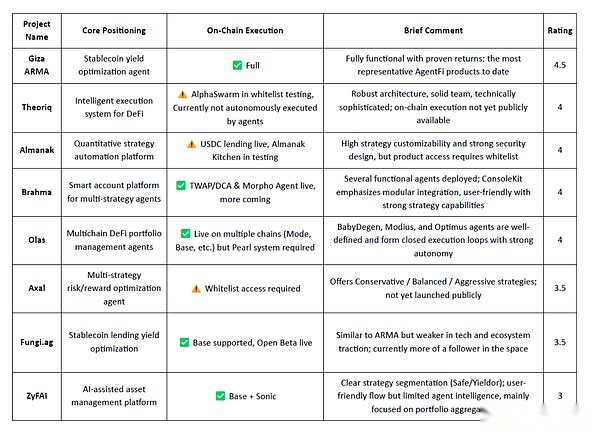
AgentFi: Reality Path and Future Prospects
There is no doubt that lending and liquidity mining are the most valuable and easiest business scenarios for AgentFi in recent days.Both fields are relatively mature in the DeFi ecosystem and are very suitable for smart proxy integration due to the following common characteristics:
-
A wide range of strategic space with multiple optimization dimensions: lending is not limited to the pursuit of high returns, but also includes interest rate arbitrage, leverage recycling, debt refinancing, liquidation protection, etc.Earning farming involves APR tracking, LP rebalancing, automatic compounding and a multi-layer strategy combination.
-
A highly dynamic environment that requires real-time perception and response: interest rates, TVL, fluctuations in incentive structures, the launch of new pools or the emergence of new protocols may all change the best strategy and require dynamic adjustments.
-
Automation creates significant execution window costs for obvious value: funds not allocated to the optimal pool can result in opportunity costs; automation enables real-time migration.
Lending vs Mining: Who is more suitable for AgentFi?
Lending-based agents are more feasible due to their stable data structure and relatively simple policy logic.Projects such as Giza ARMA have been launched and have achieved remarkable results.
In contrast, liquidity mining management is more complex: agents must respond to price and volatility changes, track fee accumulation, and perform dynamic redistribution—all of which require high-fidelity perception, reasoning, and on-chain execution.This is the core challenge that projects such as Theoriq need to solve.
Medium- and long-term AgentFi opportunities
Pendle Income Trading:
Pendle has a clear time dimension and yield curve, which is ideal for agency-managed maturity rollouts and interpool arbitrage.
Its unique structure—split the assets into PT (principal token) and YT (yield token)—makes it more compatible with the strategy combination.PT represents redeemable principal (low risk), while YT provides variable returns (high risk, suitable for mining and speculation).
Pain points suitable for automation include:
-
Manually reconfiguration after short-term pool expiration (usually 1-3 months)
-
Variations in yields and reallocated expenses for different fund pools
-
Complex valuation and hedging when PT and YT merge
The AgentFi system maps user preferences to automatic policy selection → allocation → extension → redeployment, which can greatly improve capital efficiency.
Pendle’s features—time-bound, decomposed, dynamic—make it ideal for building Yield Swarm or Portfolio Agent systems.Pendle is expected to be one of AgentFi’s flagship applications if combined with intent inputs (such as “10% annual interest rate, withdrawable within 6 months”) and automated execution.
Fund interest rate arbitrage:
In theory, it is a strategy with higher returns, but due to cross-market and cross-chain coordination, it is technically difficult.
While the on-chain options space has cooled down due to the complexity of pricing and execution, perpetual contracts remain a highly active derivative use case.AgentFi can implement smart arbitrage strategies covering financing rates, basis trading and hedging positions.
A functional AgentFi system includes:
-
Data Module – Crawl real-time financing rates and costs from DeFi and CEX
-
Decision module—Adaptively judge the opening/closing conditions based on risk parameters
-
Execution module – Deploy or exit the position once the trigger condition is met
-
Portfolio module—manage multi-chain and multi-account strategy orchestration
challenge:
-
The CEX API itself is not integrated into the current on-chain proxy
-
High-frequency trading requires low latency execution, Gas optimization and slippage protection
-
Complex arbitrage usually requires group-based agency coordination
Ethena has automated fund rate arbitrage, and although it is not yet native to AgentFi, opening up its modules and proxying its logic can evolve it into a decentralized AgentFi system.
Pledge and re-pled:
While not essentially suitable for AgentFi, LRT dynamic combination offers some prospects.
Traditional pledge operations are simple, stable returns and long unbinding cycles, which are too static for AgentFi.However, more complex structures offer opportunities:
-
Combinable LST/LRT (e.g. stETH, rsETH) avoids handling native bond complexity
-
Re-collateral + collateral + derivatives to create a more dynamic portfolio
-
Monitoring agents can track APR and AVS risks and reconfigure them accordingly
Still, restaking faces systemic challenges: hype cooling, an imbalance in supply and demand of ETH and a lack of use cases.Leading companies such as EigenLayer and Either.fi have begun transformation.Therefore, staking is more like a component module of AgentFi than a core application.
Risk-weighted assets:
Treasury-based agreements are not very suitable for AgentFi; multi-asset portfolio structures show greater potential.
Current RWA products focus on stable, low variance assets, such as U.S. Treasury bonds, which have limited room for optimization (4-5% fixed annual interest rate), low operating frequency and strict regulatory restrictions.These features make it unsuitable for high-frequency or policy-intensive automation.However, there are some development directions in the future:
-
Multi-asset risk-weighted portfolio agent – If risk-weighted assets extend to real estate, credit or accounts receivable, users can apply for a diversified portfolio of income.Agents can periodically rebalance weights, manage expiration dates, and redeploy funds.
-
Risk-weighted assets as collateral + custody reuse – some agreements tokenize Treasury bills as collateral for the lending market.Agents can automate deposits, collateral management and earnings acquisition.If these tokens gain liquidity on platforms such as Pendle or Uniswap, agents can use price/earnings differences to arbitrage and rotate funds accordingly.
Composition of exchange policy: from intent basis to complete AgentFi policy engine.
Modern switching systems mask the complexity of DEX routing through account abstraction + intent, allowing users to make simple inputs.However, these are still atomic automation, lacking real-time perception and policy-driven logic.
In AgentFi, swaps become an integral part of larger financial operations.For example:
“Distribution of stETH and USDC for maximum gain”…may involve multi-jump exchange, restaking, Pendle split, earning farming and profit recovery – all handled by the agents independently.
Swaps play a key role in:
-
Compound income strategy routing
-
Cross-market arbitrage/Delta neutral position
-
Mitigate slippage and defend against MEVs with dynamic execution and batch processing
A true AgentFi-level switching agent must support:
-
Strategy perception
-
Cross-protocol orchestration
-
Funding path optimization
-
Timed execution and risk control
The future of swap agents lies in multi-strategy integration, position rebalancing and cross-protocol value extraction – the road ahead is long.
DeFi Smart Roadmap: From Automation to Proxy Networking
We are witnessing the gradual evolution of DeFi intelligence – from automation tools to intention-driven co-pilots to autonomous financial agents.
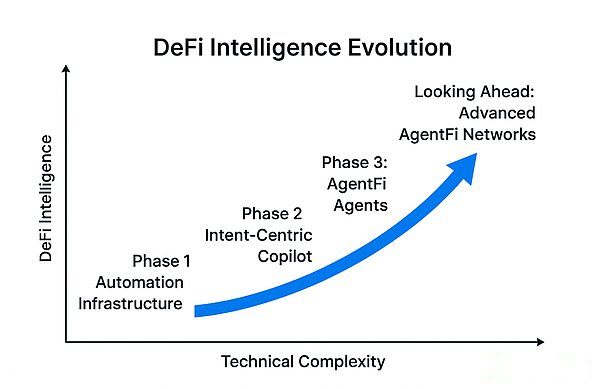
Phase 1: Automation Infrastructure
This stage focuses on relying on rule triggering and conditional execution mechanisms to automate basic operations on the chain.For example, a transaction or rebalance portfolio is performed based on a preset time or price threshold.Representative projects include Gelato and Mimic, focusing on building the underlying execution framework.
Phase 2: Intent-centered assistant
This stage turns to understanding user intentions and generating optimal execution recommendations.It’s no longer just “what should be done”, but understanding “what the user wants” and then recommending the best way to execute.Projects like Bankr and HeyElsa represent this stage, reducing the complexity of DeFi by identifying user intentions and optimizing user experience.
Phase 3: AgentFi Smart Agent
This stage marks the starting point for closed strategies and execution on autonomous chains.Smart agents can independently perceive, make decisions and execute based on real-time markets, user preferences and preset strategies, realizing all-weather non-custodial fund management.AgentFi can realize automatic funding operations without user authorization.But this also brings security and trust issues, becoming an inevitable key challenge in AgentFi system design.Representative projects include Giza ARMA, Theoriq AlphaSwarm, Almanak and Brahma, which are actively implementing policy enforcement, security frameworks and modular products.
Future Outlook: Going to Advanced AgentFi NetworkThe next stage is to build advanced AgentFi smart agents that can automatically execute complex cross-protocol, cross-asset strategies.Visions include:
-
Pendle Income Trading: Agent management PT/YT life cycle rotation and income arbitrage to maximize capital efficiency.
-
Fund interest rate arbitrage: Cross-chain arbitrage agent seizes all profitable capital spread opportunities.
-
Swap strategy combination: Convert Swap into a multi-strategy revenue engine and optimize through proxy collaborative optimization.
-
Pledge and re-pled: Agent dynamically balances the staking combination and optimizes risks and returns.
-
RWA (Real World Assets) Management: Agents configure diversified real assets on the chain to realize global revenue strategies.
This is the roadmap from automation to intelligence – from tools to DeFi smart proxy that can independently execute policies.







